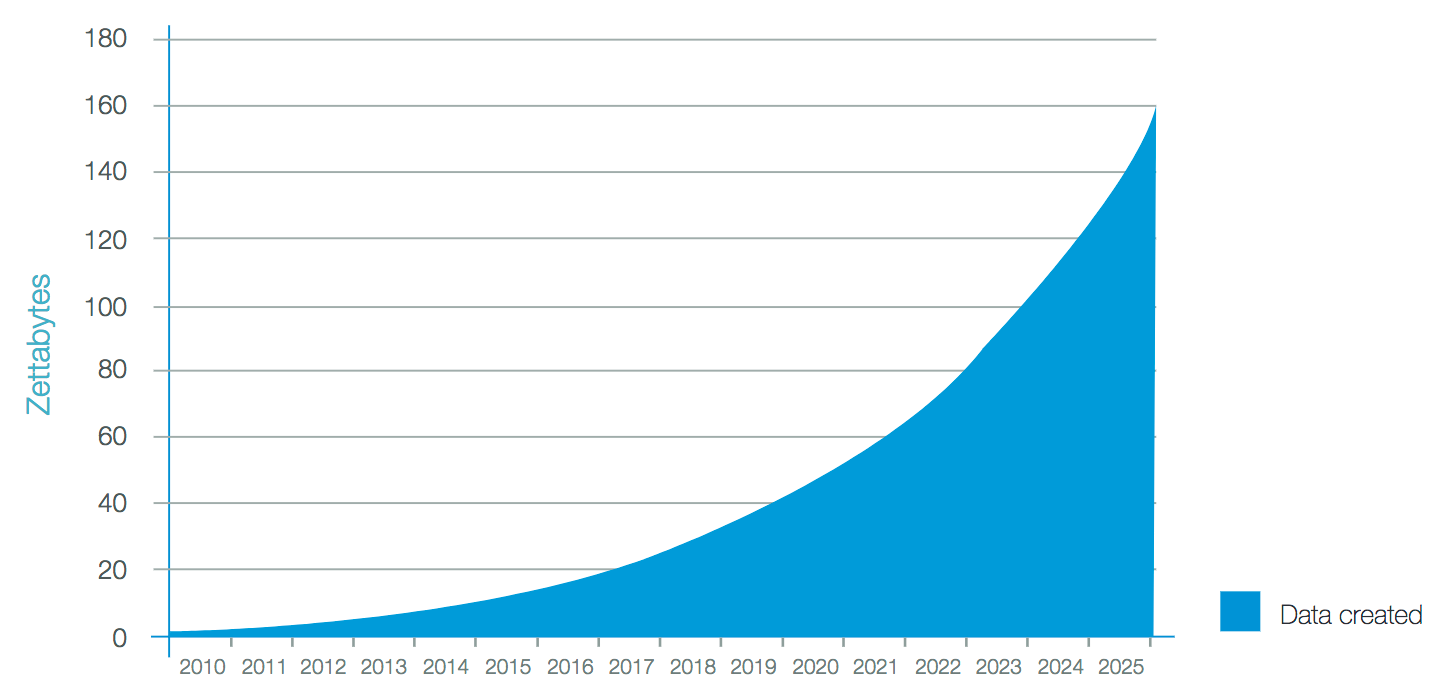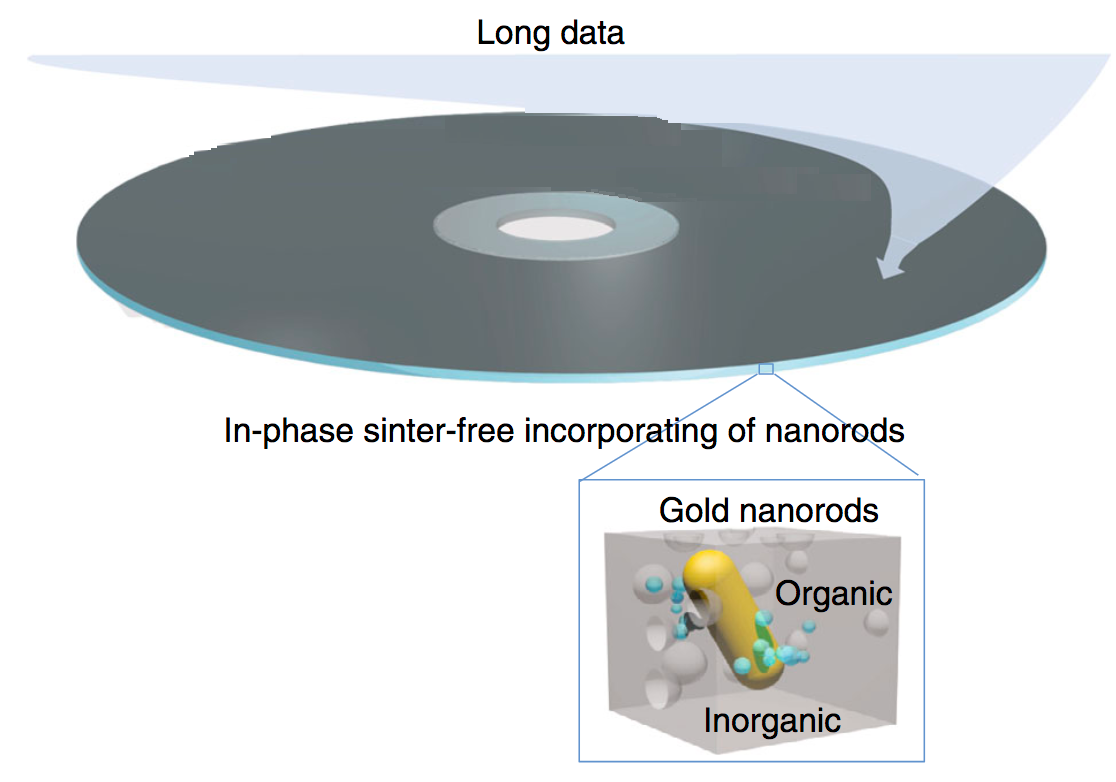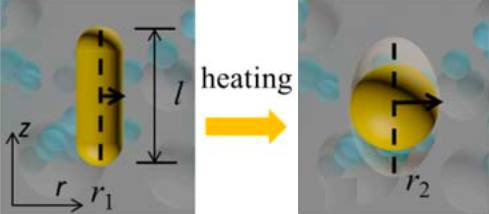Next-gen optical disc has 10TB capacity and six-century lifespan
March 26, 2018

(credit: Getty)
Scientists from RMIT University in Australia and Wuhan Institute of Technology in China have developed a radical new high-capacity optical disc called “nano-optical long-data memory” that they say can record and store 10 TB (terabytes, or trillions of bytes) of data per disc securely for more than 600 years. That’s a four-times increase of storage density and 300 times increase in data lifespan over current storage technology.
Preparing for zettabytes of data in 2025

Forecast of exponential growth of creation of Long Data, with three-year doubling time (credit: IDC)
According to IDC’s Data Age 2025 study in 2017, the recent explosion of Big Data and global cloud storage generates 2.5 PB (1015 bytes) a day, stored in massive, power-hungry data centers that use 3 percent of the world’s electricity supply. The data centers rely on hard disks, which have limited capacity (2TB per disk) and last only two years. IDC forecasts that by 2025, the global datasphere will grow exponentially to 163 zettabytes (that’s 163 trillion gigabytes) — ten times the 16.1ZB of data generated in 2016.
Examples of massive Long Data:
- The Square Kilometer Array (SKA) radio telescope produces 576 petabytes of raw data per hour.
- The Brain Research through Advancing Innovative Neurotechnologies (BRAIN) Initiative to map the human brain is handling data measured in yottabytes (one trillion terabytes).
- Studying the mutation of just one human family tree over ten generations (500 years) will require 8 terabytes of data.
IDC estimates that by 2025, nearly 20% of the data in the global datasphere will be critical to our daily lives (such as biomedical data) and nearly 10% of that will be hypercritical. “By 2025, an average connected person anywhere in the world will interact with connected devices nearly 4,800 times per day — basically one interaction every 18 seconds,” the study estimates.
Replacing hard drives with optical discs
There’s a current shift from focus on “Big Data” to “Long Data,” which enables new insights to be discovered by mining massive datasets that capture changes in the real world over decades and centuries.* The researchers say their new Long-data memory technology could offer a more cost-efficient and sustainable solution to the global data storage problem.
The new technology could radically improve the energy efficiency of data centers. It would use 1000 times less power than a hard-disk-based data center by requiring far less cooling and doing away with the energy-intensive task of data migration (backing up to a new disk) every two years. Optical discs are also inherently more secure than hard disks.
“While optical technology can expand capacity, the most advanced optical discs developed so far have only 50-year lifespans,” explained lead investigator Min Gu, a professor at RMIT and senior author of an open-access paper published in Nature Communications. “Our technique can create an optical disc with the largest capacity of any optical technology developed to date and our tests have shown it will last over half a millennium and is suitable for mass production of optical discs.”
There’s an existing Blu-ray disc technology called M-DISC, that can store data for 1,000 years, but is limited to 100 GB, compared to 6000 10 TB— 100 times more data on a disc.
“This work can be the building blocks for the future of optical long-data centers over centuries, unlocking the potential of the understanding of the long processes in astronomy, geology, biology, and history,” the researchers note in the paper. “It also opens new opportunities for high-reliability optical data memory that could survive in extreme conditions, such as high temperature and high pressure.”
How the nano-optical long-data memory technology works

The high-capacity optical data memory uses gold nanoplasmonic hybrid glass composites to encode and preserve long data over centuries. (credit: Qiming Zhang et al./Nature Communications, adapted by KurzweilAI)
The new nano-optical long-data memory technology is based on a novel gold nanoplasmonic* hybrid glass matrix, unlike the materials used in current optical discs. The technique relies on a sol-gel process, which uses chemical precursors to produce ceramics and glass with higher purity and homogeneity than conventional processes. Glass is a highly durable material that can last up to 1000 years and can be used to hold data, but has limited native storage capacity because of its inflexibility. So the team combined glass with an organic material, halving its lifespan (to 600 years) but radically increasing its capacity.

Data is further encoded by heating gold nanorods, causing them to morph, in four discrete steps, into spheres. (credit: Qiming Zhang et al./Nature Communications, adapted by KurzweilAI)
To create the nanoplasmonic hybrid glass matrix, gold nanorods were incorporated into a hybrid glass composite. The researchers chose gold because like glass, it is robust and highly durable. The system allows data to be recorded in five dimensions — three dimensions in space (data is stored in gold nanorods at multiple levels in the disc and in four different shapes), plasmonic-controlled multi-color encoding**, and light-polarization encoding.
Scientists at Monash University were also involved in the research.
* “Long Data” refers here to Big Data across millennia (both historical and future), as explained here, not to be confused with the “long data” software data type. A short history of Big Data forecasts is here.
** As explained here, here, and here.
UPDATE MAR. 27, 2018 — nano-optical long-data memory disc capacity of 600TB corrected to read 10TB.
Abstract of High-capacity optical long data memory based on enhanced Young’s modulus in nanoplasmonic hybrid glass composites
Emerging as an inevitable outcome of the big data era, long data are the massive amount of data that captures changes in the real world over a long period of time. In this context, recording and reading the data of a few terabytes in a single storage device repeatedly with a century-long unchanged baseline is in high demand. Here, we demonstrate the concept of optical long data memory with nanoplasmonic hybrid glass composites. Through the sintering-free incorporation of nanorods into the earth abundant hybrid glass composite, Young’s modulus is enhanced by one to two orders of magnitude. This discovery, enabling reshaping control of plasmonic nanoparticles of multiple-length allows for continuous multi-level recording and reading with a capacity over 10 terabytes with no appreciable change of the baseline over 600 years, which opens new opportunities for long data memory that affects the past and future.
